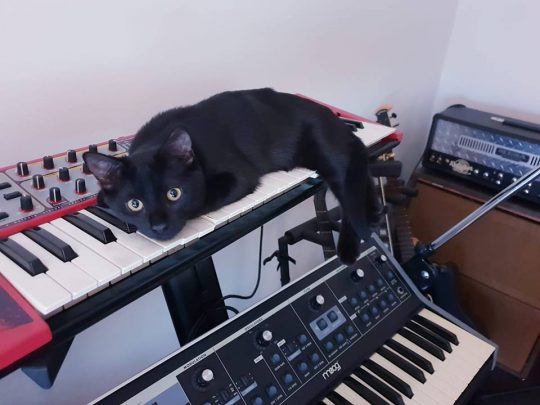
This adorable black cat has found a nice spot to rest on a Nord Modular, which happens to sit above a Moog synthesizer. From Pete Crane via Facebook.
Good thing our little
synthcat doesn’t shed too much
:3 🎹
And from resting to performing…


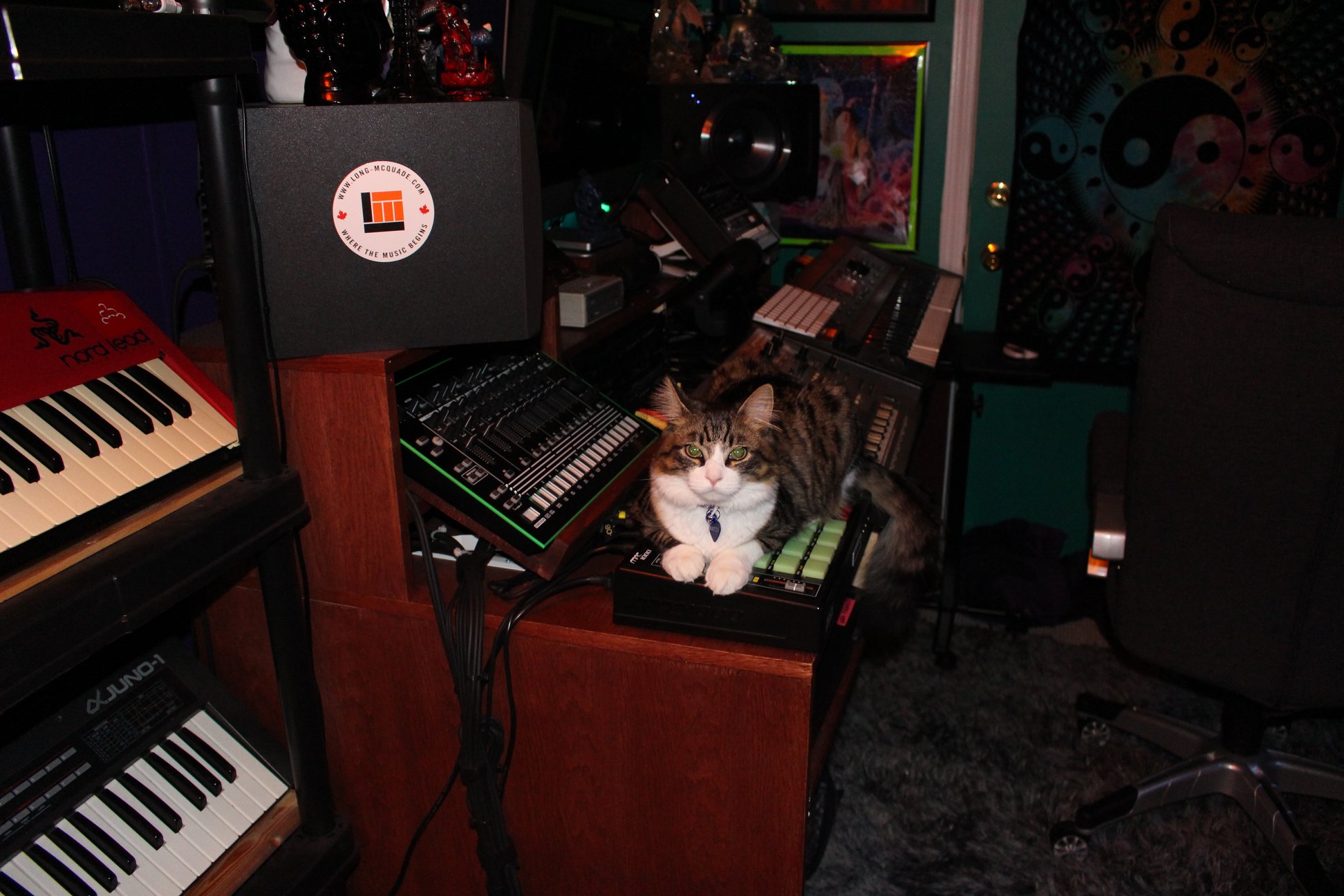
Cat sitting on an Akai MPC 1000 in a studio featuring various Roland instruments and a Nord lead. From Xeper Kalypso via the Facebook group Synthesizer Freaks.
My cat hates photos being taken of him, since he decided to do everything he could to not let me finish the work I needed to do in the studio, I took a photo
While I thoroughly enjoyed every night of this year’s Outsound New Music Summit, last Friday was special because I was on stage with my own band CDP. We shared the bill with Dire Wolves for a night of contrasting retro styles within the context of new and experimental music.
I often get asked what “CDP” stands for. And while it does stand on its own as a name, it does come from the initials of the original three members: Chaudhary, Djll, Pino. That’s me on keyboard and vocoder, Tom Djll (synthesizers), and Mark Pino (drums). Joshua Marshall joined the band in 2017, bringing his technical chops and versatility on tenor and soprano saxophone. As a road-and-map geek, it also stands for “Census Designated Place”.
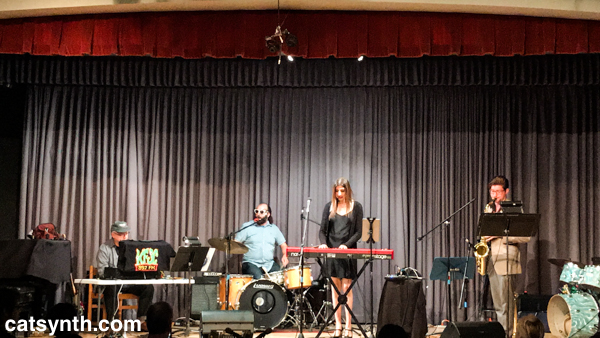
We had five tunes for this concert. Three of them were from the series I call “the jingles”, including White Wine, North Berkeley BART, and our newest song, Rambutan (it’s a fruit from Southeast Asia). Marlon Brando and Konflict Mensch rounded out the set. Each featured a melodic and harmonic head followed by open improvisation – no fixed solos, even listens to one another and comes in and out. Our style is a blend of funk, fusion and experimental music reminiscent of Herbie Hancock’s Mwandishi and Head Hunters bands or Soft Machine 5 & 6, with a bit of 1970s Frank Zappa / George Duke mixed in. The music is a joy to play and I’m so glad to be able to be on a stage playing it.
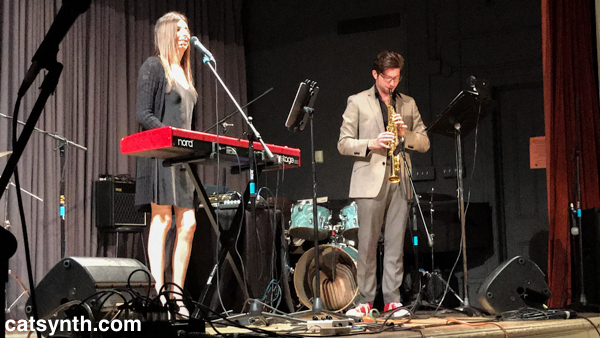 We got off to a somewhat shaky start with White Wine, but we settled down quickly as we headed into the improvisation section. From that point on, things only got better with Marlon Brando and North Berkeley BART (which is always a local crowd pleaser). Rambutan was a lot of fun, including the funky 7/4 jam and the call-and-response chant with the audience. Mark held up the metric foundation, working with both me and Tom who took turns on the bass roll. Tom also got some great sounds in his solos, as did Josh who moved easily between growls and mellifluous melodic runs.
We got off to a somewhat shaky start with White Wine, but we settled down quickly as we headed into the improvisation section. From that point on, things only got better with Marlon Brando and North Berkeley BART (which is always a local crowd pleaser). Rambutan was a lot of fun, including the funky 7/4 jam and the call-and-response chant with the audience. Mark held up the metric foundation, working with both me and Tom who took turns on the bass roll. Tom also got some great sounds in his solos, as did Josh who moved easily between growls and mellifluous melodic runs.
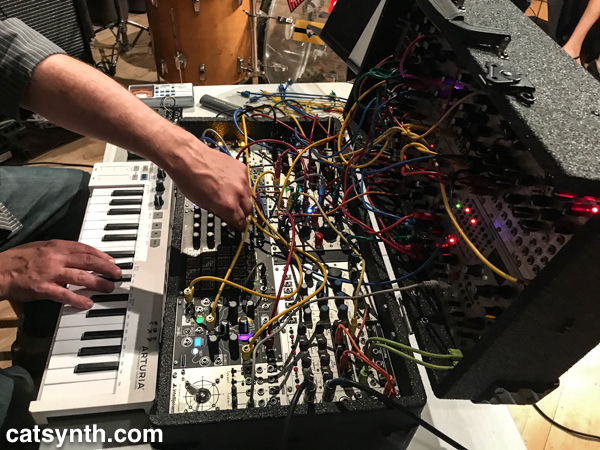
The vocoder, a Roland VP-03, held up pretty well – in some ways, I felt the scatting went even better than the lyrics – though there is still work to do keeping the voice intelligible in the context of the full band. I was exhausted and satisfied after the set, and look forward to doing more with our band.
You can read Mark Pino’s perspective on the set on his blog.
For the second set, Dire Wolves brought a completely different energy to the stage. Where CDP was exuberant and even frenetic at times, Dire Wolves welcomed the audience with a mellow and inviting psychedelic sound.

[Photo by Michael Zelner]
There was a sparseness to the music, with Jeffrey Alexander (guitar + winds), Sheila Bosco (drums), Brian Lucas (bass) and Arjun Mendiratta (violin) each staking claim to a distinct orchestral space within the soundscape. Alexander and Mendiratta had lines that melted seamlessly from one to the next; Brian Lucas’ bass was sometimes melodic. Bosco’s drums provided a solid foundation, but she also contributed voice and other sounds to the mix.

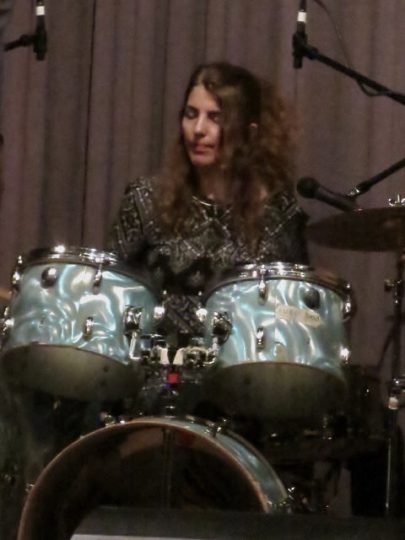
[Photos by Michael Zelner]
My mind was still processing the set we had just played, but the trance-like qualities of Dire Wolves provided a space for a soft landing and to return to a bit of balance. Sadly, it seems this was the band’s last performance for a while, at least with the current lineup. But I look forward to hearing more from each of these musicians in their other projects.
Both groups played to a decently sized and very appreciative audience – not the capacity crowds of the previous or following nights, but respectable. And I got quite a bit of positive feedback from audience members after our set. We still have one more night of the summit to cover, and then it’s onward to future events.
It’s been a busy season for Pitta of the Mind! We had three shows in the span of two months, beginning with our blue set at Pro Arts and culminating with ¡Voltage and Verse! at Adobe Books in San Francisco. You can get a taste for the show in our CatSynth TV video.
It was an honor to once again share a bill with ruth weiss. A Holocaust survivor and founding member of the San Francisco beat poet scene in the 1950s, she is still going strong, performing and supporting local institutions and artists.
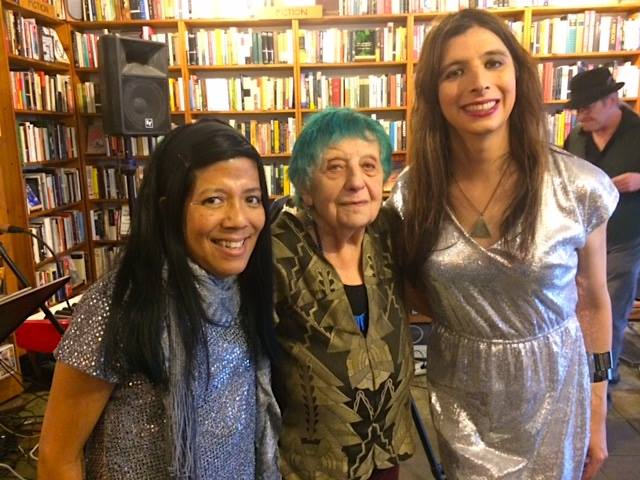
We were glad to see that she is continuing her collaboration with our friend and synthesizer virtuoso Doug Lynner. Together with log percussionist Hal Davis, they performed a set of poetry and music that simultaneously evoked earlier eras and the latest electronic experiments. Davis’ log drum provided an expressive metronome, undulating between a trot and a gallop. Lynner’s synthesizer lines filled in the spaces, sometimes with rhythmic appeggios and at other moments with long eerie drones. The synthesizer timbres and phrases complemented the words in multiple ways, sometimes underpinning the narrative in the manner of a good film score, at other times emphasizing the rhythm of the words and making them into a musical whole.
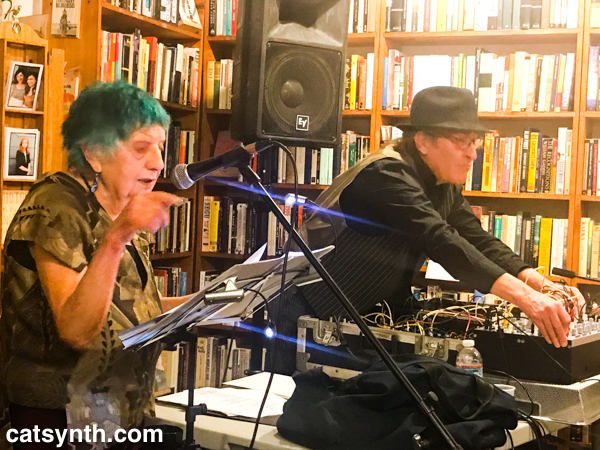
Our Pitta of the Mind set was part of a month-long celebration for the release of Maw Shein Win’s new book of poetry Invisible Gifts. The book is divided into four sections based on different colors. This works perfectly for our use of color themes in our performances. For this night, we chose silver and performed selections from the silver section of the book. There were some familiar poems that we have performed before, and some that were new to me. There were a variety of styles and subjects in the words that inspired different musical backings, from jazzy electric piano (my favorite) to abstract synthesizer explorations. I was able to reuse some of the modular patches I had developed for my recent show in Portland and make them work with the rhythm of the texts.
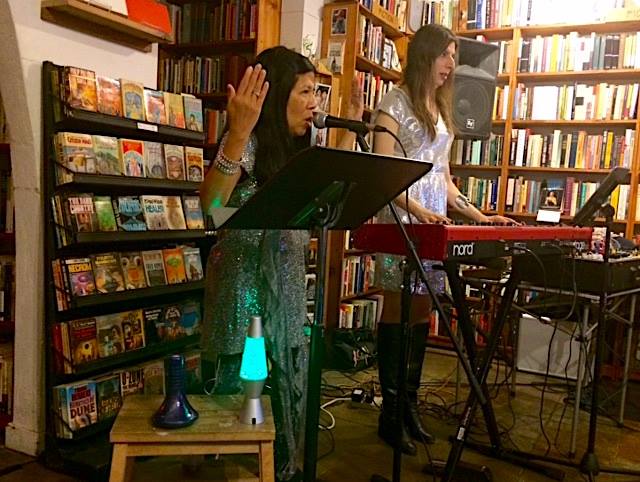
Maw and I have performed together so many times now that it has become almost second nature to realize a new set; our three shows this season went off (nearly) flawlessly, and have been among the best we have done in our nearly seven years of collaboration! We have developed a toolset and pallete of instruments (including the Nord Stage and Prophet 12) and sounds that we can quickly turn to with each new text, which makes the process of learning new pieces both simple and fun. I certainly hope we can keep up the momentum in the remainder of the year, even as I turn my own attention to other musical projects.

In between our set and weiss/Lynner/Davis, we were treated to a presentation by Ramon Sender. Sender was a co-founder (along Morton Subotnick and Pauline Oliveros) of the San Francisco Tape Music Center in the early 1960s, but on this evening he regaled us with stories of his time at the Morning Star and Wheeler ranches in Sonoma County in the late 1960s and early 1970s. Morningstar, founded by Lou Gottlieb, was a radical experiment in communal living, populated by an interesting cast of characters along with folks who “commuted” between San Francisco’s Haight-Ashbury district and the ranch west of Sebastopol. It only existed in its communal form for a short period of time before being shut down by Sonoma County. Sender and others then moved to the nearby property of artist Bill Wheeler, who followed Gottlieb’s lead and opened his ranch as a commune open to all. I found myself fascinated by Sender’s stories, and would love to learn more about the history of the area and these communal experiments.
It was a fun night of music and words that lived up to its billing, and I certainly hope to have a chance to perform with everyone again. And thanks to Benjamin Tinker and Adobe Books for hosting the event! Please support your local bookstores and performance spaces.
[Photos not marked “catsynth.com” in this article courtesy of Maw Shein Win.]
The Matzoh Man returns for Passover on CatSynth TV, this time accompanied by a Minimoog, Roland VP-03 vocoder and our trusty Nord Stage EX.
The Dayenu song is a tradition on Passover. The word dayenu approximately translates to “it would have been sufficient” and is used as a phrase of gratitude for each of the miracles recounted in the Passover Hagaddah.
Chag Pesach Sameach!
As we get ready for our next Pitta of the Mind show this Thursday, March 8, we look back at our recent show at Pro Arts in Oakland, where we were joined by Usufruct, Alex Cruse, and Murder Murder. You can see a bit of all four groups in this recent CatSynth TV episode.
Pitta of the Mind’s color theme (we always have a color or pattern theme) for this evening was blue and featured blue-themed poems by Maw Shein Win, many from her new book Invisible Gifts.
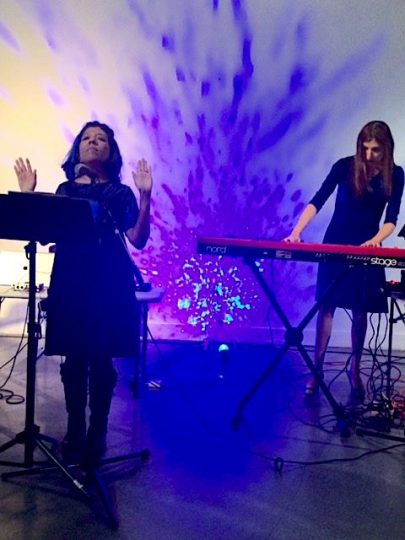
[Photo by Tom Scandura]
I used the Prophet 12 synthesizer, along with the modular system, my trusty Nord Stage, and some percussion instruments to create a musical interplay with the words as well as the space between them.
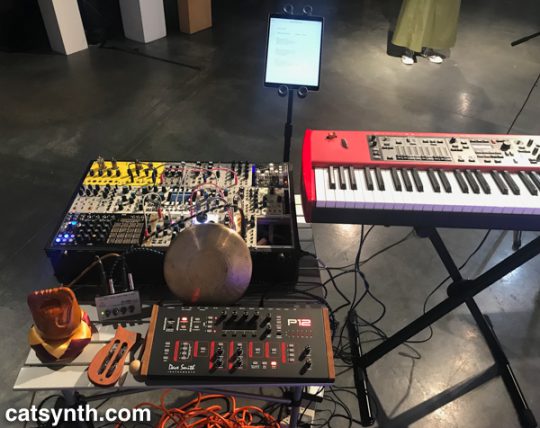
Even though we haven’t performed in a while and only had one rehearsal, I felt this was one of our strongest performances – and the feedback I got from the audience backed up that perception. In particular, I think the poem “You Will Be With Me in a Town Called Paradise” came out particularly well, with a sultry vibe and jazzy accompaniment on electric piano.
After our set, Usufruct, the duo of Polly Moller Springhorn and Tim Walters took the stage.
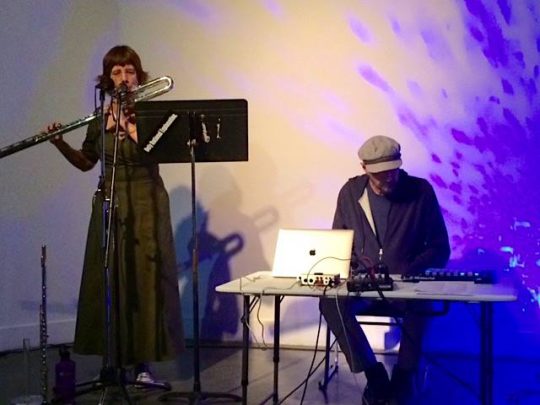
[Photo by Tom Scandura]
As the word “usufruct” implies, they make use of materials for which they have usage rights beyond ownership, such as public-domain text sources. Polly’s vocal interpretations of the texts are processed electronically by Tim using custom programs written in SuperCollider. The end result is simultaneously dark and playful. But beyond the text sections, I was particularly taken with the instrumental portion at the beginning, which featured bass flute live and electronically processed.
Alex Cruse brought a very different vibe and sensibility to the evening, with an electronic performance that focused on beats, loops, and hits.
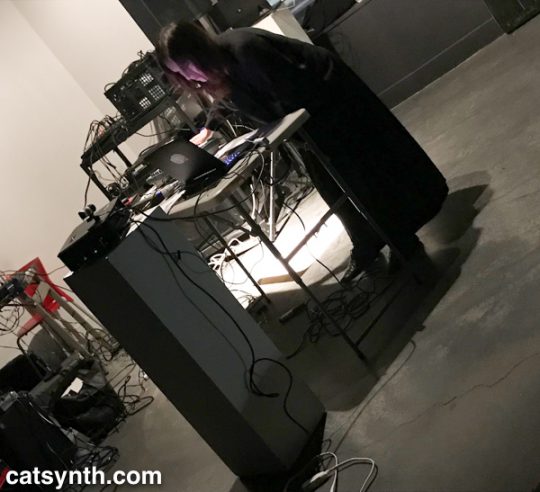
There were many delightful sounds and many hard-edged industrial noise moments as well. The vocals were deliberately obscured by heavy distortion and other processing but provided a percussive element that worked well with the rhythms.
The final set by Murder Murder was again something altogether different. With two drummers, two horns, two electronic performers, and vocals, it was nonstop intensity from the first drum hit.
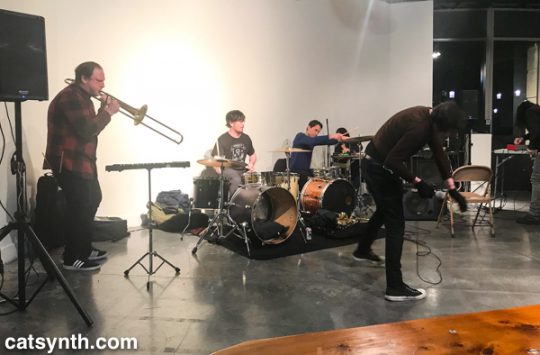
The intensity continued for several minutes and then came to a sudden close. It was the musical equivalent of a tornado tearing through our calm evening of voice and electronics, but perhaps it was a fitting coda to the evening.
We thank Pro Arts and Sarah Lockhart for having us at this series, which has become quite a mainstay of the Oakland scene. I hope to be back again soon with one of my other projects. And of course, we are looking forward to our next Pitta of the Mind Show – where we will once again be joined by Usufruct – at the Luggage Store Gallery in San Francisco on Thursday, March 8 at 8 PM.
It’s been a slow recovery from our latest bout of this year’s influenza and “NAMMthrax,” but we are getting there slowly. Indeed, I have been well enough to spend more time working in the studio again. Of course, if I am in the studio there is a good chance Sam Sam will be there, too.
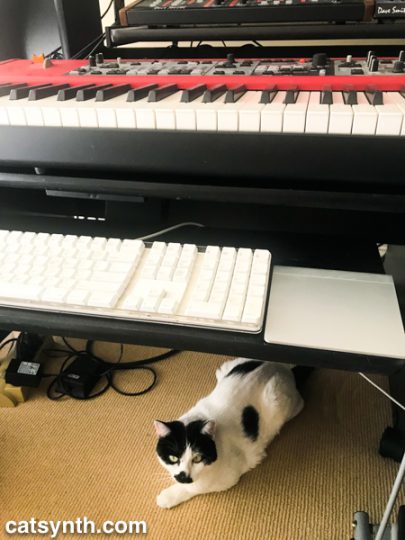
It’s always a delight to have her around. I think she is getting used to all the weird electronic sounds just as Luna did. As a more social cat, I think she mostly just enjoys being near the action. I do sometimes feel guilty when she gets comfy under the main console and I want to use the Nord. It’s a studio musician’s version of the cat-in-lap dilemma.
We are going to move forward with some video and music work today, as body and energy permit. We are also doing our part for today’s mass ritual here in the United States with our Superb Owl.

We hope you all have an enjoyable day, however you chose to fill it!
We resume of coverage of the 2018 NAMM Show after a few days break – and a nasty bout of “NAMMthrax” – with the latest spin on an old favorite: the Nord Electro 6.
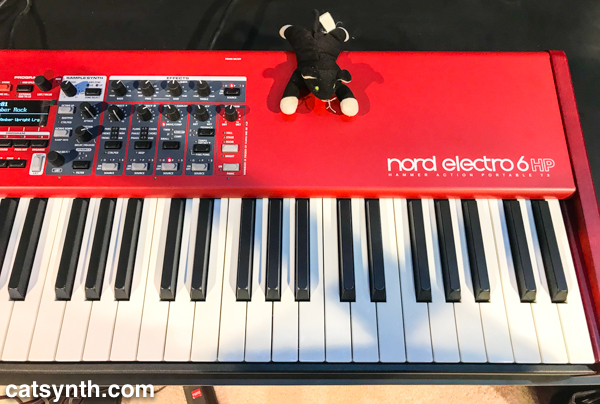
Longtime readers know that I have been a user of Nord keyboards since I got my trusty Nord Stage EX back in 2010. It has served me well, but have sometimes been envious of the features in subsequent generations, notably the expandable Piano Library and Sample Library (the original Stage does not support the sample library at all). With the Electro 6, the separation from the Stage line is much more blurred, and it calls into question the need for a Stage at all for those of us who fell in love with Nord keyboards for their electric pianos. The Electro 6 supports up to 3 layers and splits (something previously limited to the Stage). The electric piano (and acoustic piano) section is enhanced with new layering features and its own filter section that allows one to dial in different tones within a particular model. And the piano library is expandable with 1GB of memory. The organ section uses the C2D engine, and a rock organ is quite handy in a variety of situations. The sample library allows for classic Mellotron sounds as well as a variety of others. The one section from the Stage that is missing is the independent A1 synth (similar to the Lead). Personally, it is the section I use the least, so I wouldn’t miss it if I moved over to the Electro. Plus, this model would be a little bit easier to schlep back and forth to gigs.
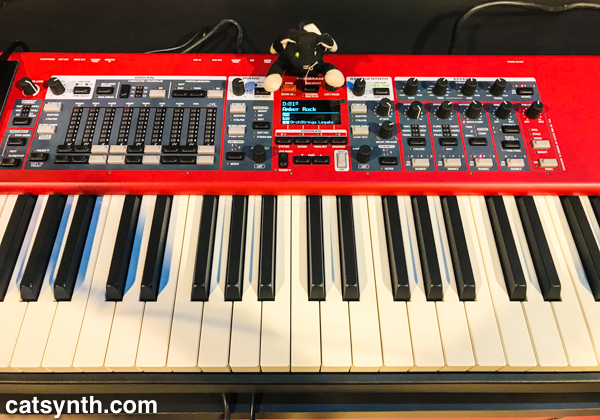
The Electro 6 comes in three models: 61-key and 73-key semi-weighted with mechanical organ drawbars; and the “HP” version with 73 fully weighted keys and LED drawbars. As a pianist, the latter would be my preference.
If you are already fortunate enough to have an Electro 4 or 5, the 6 probably won’t be a big enough change to warrant an upgrade, especially at the high prices these instruments command. But if one has been waiting eight years, it might be the time…
Sam Sam has decided that the space under the studio console is an excellent napping spot.

This is where the Nord Stage lives when not gigging, and my main Pro Tools HDX station for music recording and CatSynth TV post-production. I am loath to move her when I find her there, so I usually just wait a little bit. After all, even napping cats rarely stay in one place for long.

If the studio looks a bit messy and chaotic, that is because it is. Between gigging, travel, and probably too much gear, it has been hard to keep in order during the second half of the year. The latest dismantling was for my recent performance at VAMP, which came before I had replaced everything from my New York trip. The Nord keyboard usually makes it back in place quickly, sometimes it takes the ever-expanding collection of synths a little while longer. Hopefully in the next few quieter weeks will get it organized and better than ever…